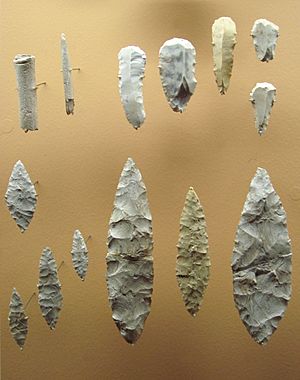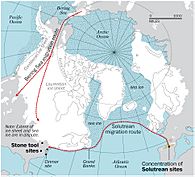Solutrean hypothesis facts for kids
The Solutrean hypothesis is a theory about how the first people arrived in the Americas. It suggests that early humans came from Europe, specifically from a group called the Solutreans. They might have traveled across the Atlantic Ocean by using pack ice as a bridge.
This idea is different from what most scientists believe. The more common theory is that the first people came to the Americas from Asia. They likely walked across a land bridge called the Bering Strait or sailed along the Pacific coast.
The Solutrean hypothesis suggests that around 21,000 years ago, people from the Solutré region in France traveled to North America. These people were known for their special way of making stone tools. Once they arrived, their tool-making style spread across the continent. This style then supposedly influenced the later Clovis tool-making techniques, which became very popular around 13,000 years ago.
The main idea behind the Solutrean Hypothesis is that the stone tools made by Solutreans and Clovis people look very similar. Supporters of this theory believe these similarities prove that Solutreans were the first to reach the Americas. This would mean they arrived much earlier than what mainstream science suggests. To support their claims, they point to archaeological finds from places like Cactus Hill in Virginia and Meadowcroft Rockshelter in Pennsylvania. They believe these sites show a link between Solutrean and Clovis tools.

The Solutrean theory was first suggested in the 1970s. It gained some support in the 2010s from researchers like Dennis Stanford and Bruce Bradley. However, most archaeologists, geneticists, and other scientists do not believe the Solutrean hypothesis is correct. They say the evidence fits better with other ideas. There's a gap of thousands of years between the Solutrean and Clovis periods. Also, the tool similarities might just be a coincidence. There is no proof that Solutreans had boats or could cross the Atlantic during the Ice Age. Recent genetic studies also show that the first Americans came from Asia, not Europe.
Contents
Amazing Stone Tools
The Solutrean culture began in what is now France, Spain, and Portugal. This was roughly between 21,000 and 17,000 years ago. Solutrean tool-making was very advanced for its time. They used techniques that were not seen again for thousands of years. These tools were much better than the older flint tools from the Mousterian period. They were also more effective than the bone and flint tools of the later Magdalenian period, which replaced Solutrean tools in Europe around 17,000 years ago.
How Solutrean Tools Were Made
The most important feature of Solutrean tools is their unique shape. They were often shaped on both sides using a technique called "percussion flaking." This means they hit the stone to chip off pieces. This shared feature is a key reason why supporters of the Solutrean hypothesis see a connection to Clovis tools.
The Clovis culture was a very early culture in North America. It is named after the special stone tools found near Clovis, New Mexico. When you look at both Solutrean and Clovis tools, they have similar looks. This has led some people to think that Clovis tools might have come from Solutrean techniques.
Clovis tools are known for a special type of spear point called the Clovis point. Both Solutrean and Clovis points are thin and shaped on both sides. They also used a technique called "overshot flaking." This method quickly made the stone thinner without making it narrower.
However, Clovis points have a unique feature called "bifacial fluting." This is a long groove carved into the bottom of the point. It helped attach the point to a spear. This fluting is found on both sides of the blade. Solutrean tools do not have this fluting.
Clovis tool-making appeared in North America between 12,800 and 13,500 years ago. Older tools with this fluting feature have not been found in Asia or Alaska. The idea of a link between Clovis and Solutrean tools is still debated. Many scientists do not widely accept it. There are big time gaps between the two cultures. Also, there's no proof Solutreans could travel by sea. Plus, Clovis tools have unique features that Solutrean tools don't.
Challenges to the Hypothesis
Genetic Evidence
Scientists have studied the DNA of ancient people to understand how the Americas were first settled. Supporters of the Solutrean hypothesis once pointed to a specific DNA group, called haplogroup X2, as possible evidence. This group is found in both parts of Europe and parts of North America. They thought this pattern might support their idea.
However, later genetic studies have largely disagreed. A 2008 article in the American Journal of Human Genetics found that haplogroup X2, along with other main DNA groups, came from a single group of early Native Americans. This group likely came from Asia. This means the DNA evidence does not support the idea of separate migrations from Europe.
More recent genetic studies in 2012 and 2014 also found strong evidence against the Solutrean theory. For example, the DNA of a 12,500-year-old infant found in Montana, called Anzick-1, was studied. This infant was found near Clovis artifacts. The DNA showed strong links to ancient people from Siberia, a region in Asia. The study clearly stated that this DNA analysis "refutes the possibility that Clovis originated via a European (Solutrean) migration to the Americas." It also showed that all existing Native American populations are related to an ancient group from or near Siberia.
A 2014 study in Nature looked at the DNA of a 24,000-year-old skeleton from Siberia. This DNA suggested that some Native American ancestry came from an ancient group in Western Eurasia. However, the study concluded that this ancestry likely arrived in the Americas through the Bering Strait from Asia, not by a journey across the Atlantic from Europe.
Dating and Tool Issues
The Solutrean hypothesis faces challenges because of the long time gap between the Solutrean and Clovis periods. There's also no clear evidence that Solutreans could travel across the ocean. Additionally, Clovis tools have specific features that are not found in Solutrean tools.
In 1970, a stone tool was found off the coast of Virginia. It was found with the remains of a mastodon, which were dated to be 22,000 years old. Some researchers, like Dennis Stanford and Bruce Bradley, suggested this tool looked like Solutrean tools. They thought it might be evidence of people in North America before the Clovis culture. They also pointed to other sites with tools that might be 16,000 to 18,000 years old.
However, other scientists have questioned these claims. They argue that the tool found with the mastodon might not be related to it. They also say that similar tools have been found in North America from much later periods. So, there's no strong reason to believe these tools are from Solutrean culture or are older than Clovis tools.
Geographic Challenges
Arthur J. Jelinek, an anthropologist, noted similarities between Solutrean and Clovis tools in 1971. But he also said that the huge distance and time difference between the two cultures made a direct link unlikely. He also believed that crossing the Atlantic with the tools and knowledge available back then would have been extremely difficult, if not impossible.
Another scientist, Lawrence G. Straus, agrees. He says there are no drawings of boats or any proof that Solutreans could travel by sea or live mainly from the ocean. While some Solutrean sites are now near the coast, they were inland during the Solutrean period. These sites show evidence of eating seashells and river fish, but not deep-sea creatures. Supporters of the hypothesis argue that any evidence of Solutrean seafaring might now be underwater due to rising sea levels.
Another challenge is the lack of other cultural evidence. For example, the famous cave paintings from places like the Cave of Altamira in Spain, which are linked to Solutrean culture, have no similar examples in the Americas.
In response, some supporters suggest that only a very specific group of Solutreans, who were good at living by the sea, made the journey. They argue this group might not have had all the cultural traits of the wider Solutrean culture. A carved bone found in Florida, depicting a mammoth, was dated between 20,000 and 13,000 years ago. Some art historians have compared it to European mammoth drawings. However, others point out that similar realistic animal art developed independently in other parts of the world, like among the San people of southern Africa. This suggests that such art could have also developed on its own in North America.
See also
 In Spanish: Hipótesis solutrense para niños
In Spanish: Hipótesis solutrense para niños




